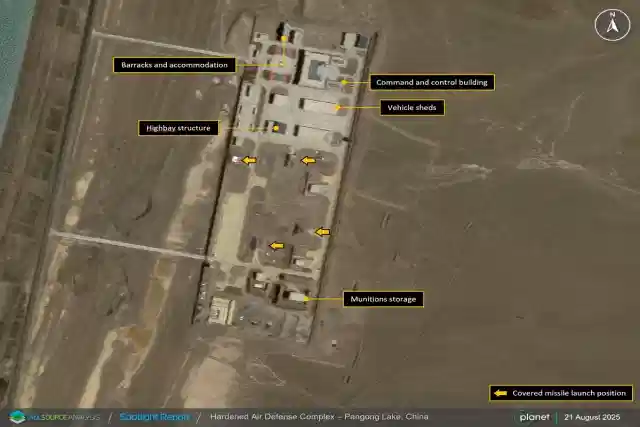News Brief
Satellite Images Reveal New Chinese Air-Defence Facility Taking Shape Near Pangong Lake In Ladakh: Report

China Expands Military Infrastructure Near Line of Actual Control (Pic Via X/AllSource Analysis)
China has constructed new air-defence complexes near the India border, with satellite imagery revealing sophisticated infrastructure at Pangong Lake and Ghar County in Tibet.
The facilities feature covered missile launch positions with sliding roofs designed to conceal HQ-9 surface-to-air missile systems.
Located roughly 110 kilometres from friction points involved in the deadly 2020 border clashes, the development marks a significant expansion of Chinese military infrastructure along the disputed Line of Actual Control.
The complex at Pangong Lake's eastern banks comprises command and control buildings, barracks, vehicle sheds, munition storage, and radar positions.
Analysis by geospatial researchers identified the site in late July, though the full extent of the covered launch facilities has only recently become apparent.
Construction activity was first spotted by geospatial researcher Damien Symon, though work on the Pangong complex remains incomplete.
The most concerning feature, defence analysts say, consists of covered missile launch positions equipped with retractable roofs. These installations accommodate Transporter Erector Launcher vehicles capable of carrying, elevating, and firing missiles.
Data connection systems using wired networks have also been installed, suggesting integration with broader Chinese military communication infrastructure across the Tibetan plateau.
The development follows years of sustained Chinese military buildup near Pangong Tso since the May 2020 border standoff that resulted in casualties on both sides.
China has simultaneously expanded its missile forces elsewhere on the Tibetan plateau, with recent satellite analysis revealing new facilities near Golmud in Qinghai Province.
The Golmud site includes large garages for transporter-erector-launchers, multiple concrete launch pads, and dome-shaped decoys designed to conceal activity from satellite observation.